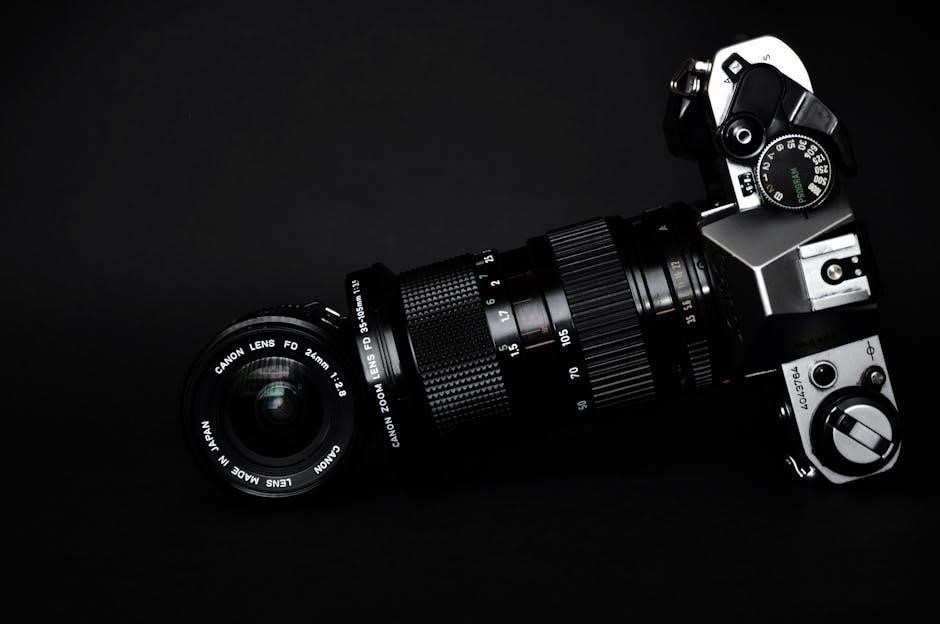The Discovery 1100 is an easy-to-use metal detector designed for outdoor adventures, featuring automated settings to simplify metal detecting for both beginners and experienced users․
1․1 Overview of the Device
The Discovery 1100 is a user-friendly metal detector designed for outdoor use, offering automated settings to simplify metal detecting․ It features push-button discrimination, 1-touch depth control, and a digital display with target ID․ The device provides 3-tone audio feedback for identifying metal types and includes sensitivity adjustment for optimizing performance in various environments․ Designed for both beginners and experienced users, the Discovery 1100 combines advanced technology with ease of operation, making it an ideal choice for treasure hunting and relic recovery․ Its robust design and intuitive controls ensure a seamless experience, while its warranty provides coverage against defects for five years․
1․2 Importance of Reading the Manual
Reading the Discovery 1100 manual is essential for maximizing its performance and ensuring a smooth user experience․ The manual provides detailed guidance on assembly, battery installation, and operation, helping users understand the device’s features and settings․ It also covers troubleshooting common issues, such as false signals and sensitivity adjustments․ By following the manual, users can avoid potential pitfalls and optimize the detector’s functionality․ Whether you’re a seasoned enthusiast or a beginner, the manual serves as a comprehensive guide to unlocking the full potential of the Discovery 1100, ensuring you get the most out of your metal detecting adventures․

Key Features of the Discovery 1100
The Discovery 1100 features automated settings, push-button discrimination, 1-touch depth control, digital display, target ID, and 3-tone audio feedback, making it user-friendly and highly efficient for metal detecting․
2․1 Automated Settings for Ease of Use
The Discovery 1100 features automated settings that simplify metal detecting, making it ideal for both beginners and experienced users․ These settings eliminate the need for complex manual adjustments, allowing you to start detecting quickly․ The device automatically handles ground mineralization and interference, reducing false signals and ensuring smooth operation․ This automation enables users to focus on their search without worrying about intricate configurations, making the process more enjoyable and efficient․ The streamlined design ensures that even those new to metal detecting can achieve professional-grade results with minimal effort․
2․2 Push-Button Discrimination
The Discovery 1100 offers push-button discrimination, allowing users to quickly customize their search preferences․ This feature lets you eliminate unwanted target signals, such as those from trash or common metals․ With a simple button press, you can adjust the detector to focus on valuable items like coins, jewelry, or relics․ The push-button interface is intuitive, making it easy to refine your search settings in real-time․ This ensures that your metal detecting sessions are more productive and efficient, as you can avoid wasting time on non-target objects․ The discrimination feature enhances the overall accuracy and effectiveness of your searches․
2․3 1-Touch Depth Control
The Discovery 1100 features a convenient 1-Touch Depth Control, allowing users to quickly adjust the detection depth with minimal effort․ This feature simplifies the process of optimizing the detector for different search conditions; By pressing a single button, you can increase or decrease the depth range, ensuring better performance in various terrains․ This intuitive control helps beginners achieve accurate results without extensive setup, while experienced users can fine-tune their searches for specific targets․ The 1-Touch Depth Control enhances the detector’s versatility, making it suitable for a wide range of metal detecting scenarios, from shallow relic hunting to deeper treasure searches․ This feature is a key advantage of the Discovery 1100․
2․4 Digital Display and Target ID
The Discovery 1100 features a digital display that provides clear visual feedback during operation, including target identification and depth information․ This display helps users quickly understand the nature of detected objects, such as distinguishing between ferrous and non-ferrous metals․ The Target ID system offers numerical identification, allowing for precise metal recognition․ Combined with the 3-tone audio feedback, the digital display enhances the user experience, making it easier to pinpoint targets accurately․ This feature is particularly useful for beginners, as it simplifies the learning process and ensures efficient metal detecting in various environments․ The digital interface is intuitive and user-friendly, adding to the detector’s overall efficiency․
2․5 3-Tone Audio Feedback
The Discovery 1100 incorporates a 3-tone audio feedback system, providing distinct sounds for different types of metals․ This feature allows users to identify potential targets without constantly viewing the display․ Low tones indicate ferrous metals like iron, while high tones signal non-ferrous metals such as silver or gold․ A mid-tone is reserved for other non-ferrous metals, offering clear differentiation․ This audio feedback enhances efficiency, as users can concentrate on scanning while listening to the tones․ The system is particularly useful in noisy environments, ensuring that important signals are not missed․ The tones can be adjusted for clarity, making the detector versatile and user-friendly․

Assembly and Initial Setup
Begin by unpacking and inventorying all components, ensuring everything is included․ Assemble the detector correctly, following the manual’s guidance, and install batteries before first use․
3․1 Unpacking and Inventory
Begin by carefully unpacking the Discovery 1100 metal detector and its accessories․ Ensure all components, such as the control box, search coil, stem, and batteries, are included․ Check for any visible damage or missing items․ Review the contents list in the manual to confirm everything is accounted for․ Familiarize yourself with each part to understand its purpose․ Store all items in a safe, dry place to prevent damage․ Before proceeding with assembly, ensure you have all necessary tools and materials ready․ A thorough inventory ensures a smooth setup process and prevents delays during initial use․
3․2 Correct Assembly Techniques
Assemble the Discovery 1100 by attaching the search coil to the stem using the provided bolts and washers․ Ensure a snug, secure connection without overtightening․ Align the coil with the stem for proper balance and optimal performance․ Next, connect the stem to the control box, making sure it clicks firmly into place․ Tighten the connecting collar to secure the stem․ Adjust the stem length to a comfortable height for ease of use․ Double-check all connections to ensure stability and proper alignment․ Avoid over-tightening, as this may damage the components․ Once assembled, test the detector by turning it on and ensuring all functions operate smoothly․
3․3 Battery Installation and Management
Install four AA alkaline batteries in the control box, ensuring correct polarity․ Avoid using rechargeable batteries for optimal performance․ Regularly check battery voltage to maintain functionality․ Turn off the detector when not in use to conserve power․ Replace batteries every 20 hours of use or when sensitivity decreases․ Keep spare batteries handy for uninterrupted detecting sessions․

Basic Operation of the Discovery 1100
Power on the detector and adjust sensitivity for optimal performance․ Use the control panel to select modes and customize settings․ Begin scanning slowly, ensuring coil coverage for accurate detection․
4․1 Powering On and Initial Setup
To power on the Discovery 1100, insert the batteries and press the power button․ The device will initialize, and the digital display will light up․ Begin by setting the sensitivity to a low level to minimize false signals, especially if you’re new to metal detecting․ Use the control panel to select the desired mode and adjust settings as needed․ Perform a quick ground balance if necessary and ensure the coil is properly aligned; Once set up, the detector is ready for scanning․ Always refer to the manual for specific instructions on initial calibration and customization for optimal performance․ Proper setup ensures accurate detection․
4․2 Understanding the Control Panel
The Discovery 1100’s control panel is user-friendly, featuring intuitive buttons for mode selection, discrimination, sensitivity, and depth adjustment․ The digital display provides real-time information, including target ID and depth readings․ Dedicated buttons allow quick access to settings like audio tone and notch filters․ The control panel is designed for easy navigation, enabling users to adjust settings on the go․ Familiarize yourself with each button’s function to optimize your detecting experience․ Proper use of the control panel ensures precise control over the detector’s performance, helping you identify targets accurately and efficiently․ Regular practice will enhance your proficiency in using these controls effectively․
4․3 Basic Scanning Techniques
Mastering basic scanning techniques with the Discovery 1100 ensures effective metal detection․ Start by holding the detector steady, keeping the coil 1-2 inches above the ground․ Sweep the coil slowly and evenly, overlapping each pass to cover the area thoroughly․ Avoid lifting the coil too high, as sensitivity decreases with distance․ Move at a steady pace to maintain consistent coverage․ Practice listening to audio cues, as they indicate potential targets․ For better results, scan in a grid pattern to methodically search the ground․ Consistency in scanning technique improves detection accuracy and helps locate hidden treasures efficiently․ Regular practice enhances your skills․
4․4 Adjusting Sensitivity
Adjusting sensitivity on the Discovery 1100 is crucial for optimizing performance․ Start with a lower setting to minimize false signals, especially in mineral-rich areas․ Use the sensitivity button on the control panel to increase or decrease the level․ In environments with high mineral content, reduce sensitivity to avoid interference․ Conversely, in cleaner areas, higher sensitivity can detect smaller or deeper targets․ Be cautious not to set it too high, as this may cause instability or noise․ Listen to audio feedback to find the balance between clear signals and minimal noise․ Adjusting sensitivity may require trial and error, but it enhances detection accuracy and overall experience․

Advanced Features and Settings
The Discovery 1100 offers advanced features like discrimination, notch settings, and target identification to enhance your metal detecting experience and improve accuracy in various environments․
5․1 Discrimination and Notch Settings
The Discovery 1100 allows users to refine their metal detecting experience with advanced discrimination and notch settings․ Discrimination enables the detector to ignore unwanted metals like iron or aluminum, while notch settings let you customize which signals to accept or reject․ These features help minimize false signals and focus on valuable targets․ By adjusting these settings, users can optimize performance for specific environments, such as beaches or fields with high mineral content․ Proper use of discrimination and notch settings requires understanding the target response and adjusting accordingly, as detailed in the manual․ This ensures efficient and accurate metal detection with minimal interference․
5․2 Target Identification and Response
The Discovery 1100 enhances metal detecting with its advanced target identification and response system․ The digital display provides clear target ID, indicating the type of metal detected, while the 3-tone audio feedback offers distinct alerts for different metals․ This feature helps users quickly identify potential treasures without digging unnecessary holes․ The detector’s automated settings further refine target response, minimizing false signals and ensuring accurate results․ By understanding the visual and audio cues, users can efficiently pinpoint valuable items, making their metal detecting adventures more productive and enjoyable․ This system is particularly useful for beginners, as it simplifies the process of identifying targets effectively;
5․3 Audio Tone Adjustments
The Discovery 1100 features a 3-tone audio feedback system, providing distinct sounds for different types of metals․ Users can adjust the tone settings to customize the audio response, enhancing their detecting experience․ This feature allows for better identification of targets, as each tone corresponds to specific metal types․ The manual provides guidance on how to fine-tune these settings, ensuring optimal performance in various environments․ By personalizing the audio feedback, users can improve their ability to distinguish between valuable finds and unwanted objects, making the detecting process more efficient and enjoyable․ This adjustability is a key advantage for both novice and seasoned detectors․

Maintenance and Care
Regularly clean the detector with a soft cloth and avoid harsh chemicals․ Store in a dry place, away from extreme temperatures․ Check coil and connections for optimal performance․
6․1 Cleaning the Device
Cleaning the Discovery 1100 metal detector is essential for maintaining its performance․ Use a soft, dry cloth to wipe down the entire unit, paying special attention to the coil and metal surfaces․ Avoid using harsh chemicals, abrasive materials, or excessive moisture, as these can damage the device․ For stubborn dirt or debris, lightly dampen the cloth with water, but ensure no liquids seep into the electronics․ Regular cleaning prevents dirt buildup and ensures accurate detection results․ Always inspect the coil and control panel for dust or grime and clean them gently to maintain optimal functionality․
6․2 Storage Recommendations
Proper storage is crucial to maintain the Discovery 1100 metal detector’s performance and longevity․ Store the device in a dry, cool place away from direct sunlight and moisture․ Use a protective case or cover to shield it from dust and physical damage․ Avoid extreme temperatures, as they may affect the detector’s sensitivity․ Ensure all components, including the coil and control panel, are clean and dry before storage․ For extended periods, remove the batteries to prevent corrosion․ Always inspect the detector for damage before and after storage to ensure it remains in optimal working condition for future use․

6․4 Regular Software Updates

Regular software updates are essential to ensure the Discovery 1100 metal detector operates at peak performance․ Updates may include improved algorithms for target detection, enhanced discrimination capabilities, and bug fixes․ To update the software, visit the official Bounty Hunter website and follow the provided instructions for downloading and installing the latest version․ Always back up your settings before performing an update․ Keep your device connected to a power source during the update process to prevent interruptions; Updating regularly will ensure you have access to the latest features and improvements, optimizing your metal detecting experience and accuracy in the field․

Troubleshooting Common Issues
Common issues with the Discovery 1100 include false signals, battery life problems, and display malfunctions․ Refer to the manual for solutions and best practices to minimize disruptions during use․
7․1 False Signals and Interference
False signals and interference can occur due to environmental factors like mineral-rich soil or nearby electronic devices․ To address this, reduce sensitivity settings or adjust discrimination levels to filter out unwanted signals․ Ground balancing may also help minimize interference․ Ensure the detector is not near other electronic equipment, and avoid using it in areas with high levels of electromagnetic interference․ Regularly checking and replacing batteries can also prevent false signals caused by low power․ Refer to the manual for specific troubleshooting steps to optimize performance and reduce unnecessary detections․
7․2 Battery Life Issues
Battery life issues can arise if the detector is used extensively or if settings are not optimized․ High sensitivity levels, frequent use of audio feedback, and prolonged operation in challenging environments can drain batteries quickly․ To extend battery life, ensure you use high-quality, rechargeable batteries and avoid extreme temperatures․ Turn off unnecessary features when not in use and store the detector properly when idle․ If battery life remains short, check for corrosion in the battery compartment and clean it as needed․ Refer to the manual for specific battery management tips to ensure optimal performance and longevity of your Discovery 1100 metal detector․
7․3 Display Malfunctions
Display malfunctions on the Discovery 1100 may occur due to incorrect settings, low battery, or physical damage․ If the digital display fails to show readings, ensure the device is powered on and batteries are functioning properly․ Check for dirt or moisture on the screen, as these can interfere with visibility․ If issues persist, restart the detector by turning it off and on again․ For severe malfunctions, refer to the manual for troubleshooting steps or contact customer support․ Regular software updates and proper handling can prevent such issues, ensuring reliable performance during your metal detecting adventures․ Always maintain the device as recommended․

Warranty Information
The Discovery 1100 metal detector is warranted against defects in materials and workmanship for five years from the date of purchase, covering repairs or replacements under normal use conditions․
8․1 Coverage and Duration
The Discovery 1100 metal detector is covered by a five-year warranty from the date of purchase, protecting against defects in materials and workmanship under normal use․ This warranty ensures repairs or replacements are made at the manufacturer’s discretion, providing peace of mind for users․ Coverage includes faulty components and manufacturing issues but excludes damage caused by misuse, accidents, or unauthorized modifications․ The warranty period is non-transferable and applies only to the original purchaser․ Proper registration and adherence to usage guidelines are essential to maintain warranty validity․ This comprehensive coverage underscores the manufacturer’s commitment to product quality and customer satisfaction․
8․2 Conditions and Exclusions
The warranty for the Discovery 1100 metal detector excludes coverage for damages resulting from misuse, tampering, or unauthorized modifications․ Normal wear and tear, as well as issues caused by improper storage or maintenance, are not covered․ Additionally, the warranty does not apply to third-party accessories or components not approved by the manufacturer․ Claims must be accompanied by proof of purchase, and repairs must be performed by authorized service centers․ Misuse of the device, such as operation in extreme environmental conditions beyond specified limits, may void the warranty․ Proper registration and adherence to the user manual are required to maintain warranty eligibility․
The Discovery 1100 metal detector is a versatile and user-friendly device, ideal for both beginners and experienced users, offering a comprehensive guide for effective metal detecting adventures․
9․1 Final Tips for Effective Use
To master the Discovery 1100, start with low sensitivity to avoid false signals and gradually increase as needed․ Regularly update software for optimal performance and utilize ground balancing for accurate detection․ Always store the device in a dry, cool place to maintain functionality․ Practice proper handling to ensure longevity and refer to the manual for troubleshooting common issues․ By following these guidelines, users can maximize their metal detecting experiences and uncover hidden treasures with ease․
